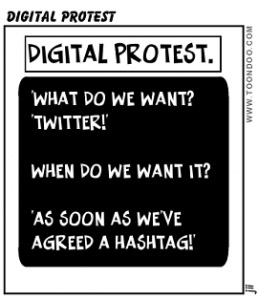 How many times in your life have you heard “That ain’t gonna happen” from a supervisor, a co-worker, a friend about one topic or another? How many times have you heard that phrase in particular from a senior officer about your department adopting new procedures, new technologies, and maybe even about your department using Social Media? “That ain’t gonna happen” can sometimes be the motto of people who cannot see beyond the way things have been done for years. Things can feel comfortable when there is no change. The words, “That ain’t gonna happen,” are ones I could live without ever hearing again, although I know I will. It seems there is always a naysayer. But, I’ve also heard those words magically turn from “That ain’t gonna happen” to “How soon can we get it done?” Sometimes all it takes is a little perseverance and patience.
How many times in your life have you heard “That ain’t gonna happen” from a supervisor, a co-worker, a friend about one topic or another? How many times have you heard that phrase in particular from a senior officer about your department adopting new procedures, new technologies, and maybe even about your department using Social Media? “That ain’t gonna happen” can sometimes be the motto of people who cannot see beyond the way things have been done for years. Things can feel comfortable when there is no change. The words, “That ain’t gonna happen,” are ones I could live without ever hearing again, although I know I will. It seems there is always a naysayer. But, I’ve also heard those words magically turn from “That ain’t gonna happen” to “How soon can we get it done?” Sometimes all it takes is a little perseverance and patience.
If you would like to champion the cause for Social Media in your department, here are some ideas to help you present a good case for it.
- Learn as much as you can about social media and what it offers. Read about the benefits and pitfalls.
- Start using social media for yourself. Get your feet wet. See how it all works.
- Become the resident expert in social media – attend seminars, read everything you can about it online, follow the experts on Twitter, etc.
- Research how other departments your size are using Social Media. Talk to them and find out what works and what does not. What are their policies?
- Write up a list of different sections of your department and how social media could help them get information out to the community or how they can receive information from the community.
- Write-up a strategic plan for the department’s use of Social Media, including who will monitor the accounts, what will be posted, etc.
- Present your plan to your immediate superior and get them to buy in. Let them know how this plan will benefit him/her and how it can make them look good too.
- Present this plan to your command staff in a professional manner. Include your research, a well thought out implementation plan, and a preliminary Social Media policy for your General Orders.
If you meet with resistance, remember to always pick your battles wisely. Law Enforcement holds dear it’s long and storied traditions. If you have a command staff that is open to new ideas and is not afraid to try new things, you are golden. But if you have a command staff that sees Social Media as a potential threat, you are in for an uphill battle. And sometimes it’s best to wait until leadership becomes more open to the idea.
If you meet with positive response, great! Implement your plan and be proud of your efforts and continue to work to make it successful. If you are met with resistance, hang in there. You may be able to try again at a later time. One thing is for sure, if you do not try, you can be positive “that ain’t gonna happen.”











